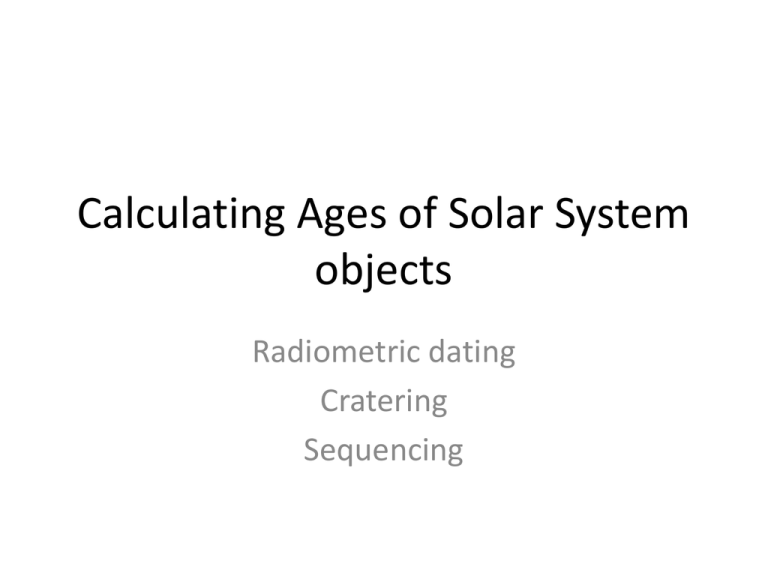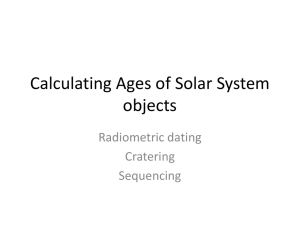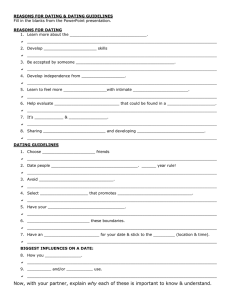Calculating Ages of Solar System objects Radiometric dating Cratering
advertisement

Calculating Ages of Solar System objects Radiometric dating Cratering Sequencing Radiometric Dating using radioactive decays P Parent Element D Daughter Element Half-life – time it takes for ½ of Parent to decay into Daughter. Examples of radioactive isotopes - 238U half-life = 4.5 Gyr 232Th half-life = 3.5 Gyr 14C half-life = 6,000 yrs (Carbon dating) See also pages 248-250 for more on radiometric dating! Fill this in based on the next slide. Number of Time Number of half lives (years) Parents 0 1 2 3 4 5 Fraction parents still left Number of Daughters # Daughter/ # Parent Assume we’re using an element with a half-life of 5 million years Radioactive Decay, cont. At time = 0, the rock formed 1 half-life later… 32 Parent Atoms 0 Daughter (P) (D) ______ yrs total Clicker question now 16 Parent 16 Daughter 16 units of heat energy How many parents are left after 2 half lives? 1. 8 2. zero 0 0 1 2 3 4 5 6 7 8 9 10 11 21 22 23 24 25 26 27 28 29 30 31 12 13 14 15 16 17 18 19 20 Assume we’re using an element with a half-life of 5 million years Radioactive Decay, cont. At time = 0, the rock formed 1 half-life later… 32 Parent Atoms 0 Daughter (P) (D) ______ yrs total 16 Parent 16 Daughter 16 units of heat energy ______ yrs total ______ yrs total After 2 half-lives 8 24 8 more units of energy, 24 total ______ yrs total 4 half lives Clicker question now After 3 half-lives 4 28 1 31 ______ yrs total 2 30 5 half-lives After 6 half lives … Do you think Carbon dating is effective for a 1 million year old fossil? 1. Yes 2. No 0 0 Why or why not? Then how do we measure old things’ ages? 1 2 3 4 5 6 7 8 9 10 11 21 22 23 24 25 26 27 28 29 30 31 12 13 14 15 16 17 18 19 20 Element P decays into element D with a half-life of 10 million years. You find 3 times as many daughters as parents. (D/P = 3) How old is the rock? 1. 2. 3. 4. 5. 6. 5 million years 10 million years 20 million years 30 million years 40 million years I have no clue You find an animal skeleton that has 1/8th as much carbon14 in it as living samples have. How old is the skeleton? 1. 2. 3. 4. 5. 6. 3,000 years 6,000 years 9,000 years 12,000 years 18,000 years 24,000 years Radiometric dating • Any questions? • Radiometric dating also called: – Carbon dating (Carbon-14 dating) if using C. – Radioactive dating – Radioisotope dating. – I won’t call it by these names. These names won’t be on your test. Review: Simplified History Formation - 4.6 Gyrs ago Present Heavy Cratering ~ ½ Gyrs Cooling, cratering declines ~ 4 Gyrs Recall: 1 Gyr = 1 billion years This history was determined by radiometric dating of rocks ON THE MOON! Note: the Sun is ________ years old. It’s 50% burned out. How much longer will it last? California Elementary School Science Standards for solar system • From California Science Standards, high school Students know the evidence from geological studies of Earth and other planets suggest that the early Earth was very different from Earth today. Students know the evidence for the dramatic effects that asteroid impacts have had in shaping the surface of planets and their moons and in mass extinctions of life on Earth. Crater Formation Before 11-70 km/sec! Why is 11 km/sec minimum? Rocky or icy objects (also called ___ & ___ ) This is going to leave a mark… Impact site’s ground gets vaporized. So does the impactor! Craters Ejecta Central Peak Rim An object this size Will make a crater this big! Diameter of crater is about 10x diameter of rock. Depth of crater is about 1-2x the diameter of rock. See also p. 264-265 Minimum impact speed for craters on the Moon is ____ than it is on Earth. 1. 2. 3. 4. 0 0 0 0 Faster Slower Same Not enough information 1 2 3 4 5 6 7 8 9 10 21 22 23 24 25 26 27 28 29 30 11 12 13 14 15 16 17 18 19 20 16 Crater Rays Recent impact crater Degas Located on Mercury These streaks of ejecta are called “rays”. Bright initially, but solar wind fades them over about 100 million years because solar wind particles chemically alters them. Most prominent under direct illumination (at what time, locally?). So, how can you find the youngest craters on the Moon? rays Crater Sizes Small < 25 km Big - up to 200 km Note the central peaks This puppy is the size of the L.A. basin! And… REALLY HUGE!! Also known as “multi-ring impact basins” Similar, but a bit larger crater formed on Mercury, and on the opposite side, we see “weird terrain” see page 274. That just had to hurt. Big crater on the Moon How do we measure ages? 1. Relative dating – Principle of Superposition Ordering of events based on appearance. 2. Crater counts – surfaces with lots of craters are new or old? [clicker] Why? (see p. 269-271) 3. Radiometric dating of rocks. (see also section 8.5) Called “Carbon dating” when used on recent fossils. Lots of craters on the ground. The ground is: 1. Old 2. New 0 0 1 2 3 4 5 6 7 8 9 10 11 12 13 14 15 16 17 18 19 20 21 22 23 24 25 26 27 28 29 30 31 32 33 34 35 36 37 38 39 40 41 42 43 44 45 46 47 48 49 50 Relative Surface Dating – Can you order the events? A. Volcanic Eruption B. Earthquake C. Crater D. Hills E. Cratered Terrain (Hint: old or new? Created when?) F. Crater G. Crater When did the volcano happen? 1. Before earthquake 2. After earthquake 0 0 1 2 3 4 5 6 7 8 9 10 11 12 13 14 15 16 17 18 19 20 21 22 23 24 25 26 27 28 29 30 31 32 33 34 35 36 37 38 39 40 41 42 43 44 45 46 47 48 49 50 A Real Example - Iapetus Iapetus is one of Saturn’s moons. Picture taken by Cassini Scarp (Shrinkage quake) & subsequent landslide There is cratering on ground. Do you see many or few craters in this red crater? What does that tell you about the circled crater? Is old or new? Crater Rim Smaller Crater What can you say about the age of the small crater? Landslide? Iapetus – entire moon • Diameter = 1460 km • Here’s the “big crater” we just looked at. • Approx 500 km across • Landslide is here. • Ridge all along equator. Mystery! • In Fall 2009 – the light/dark hemispheres mystery was solved. Ages • Now you know how astronomers calculate ages. • Study for the last test. • It is NOT cumulative.







